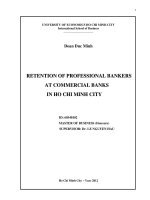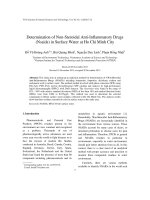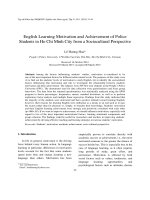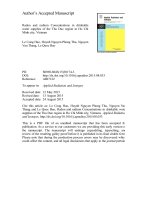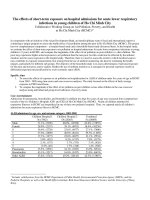The impact of land cover changes on land surface temperature in ho chi minh city based on landsat imagery
Bạn đang xem bản rút gọn của tài liệu. Xem và tải ngay bản đầy đủ của tài liệu tại đây (2.25 MB, 66 trang )
THAI NGUYEN UNIVERSITY
UNIVERSITY OF AGRICULTURAL AND FORESTRY
NGUYEN CAM TU
THE IMPACT OF LAND COVER CHANGES ON LAND
SURFACE TEMPERATURE IN HO CHI MINH CITY BASED
ON LANDSAT IMAGERY
BACHELOR THESIS
Study Mode
Major
Faculty
Batch
:Full-time
:Environmental Science and Management
:Advanced Education Program Office
:2014 - 2018
Thai Nguyen, 25/09/2018
i
Thai Nguyen University of Agricultural and Forestry
Degree Program
Bachelor of Environmental Science and Management
Student name
NGUYEN CAM TU
Student ID
DTN1453110150
Thesis Title
The impact of
Land Cover Changes on Land Surface
Temperature in Ho Chi Minh City based on Landsat
Imagery.
Supervisor (s)
Assoc. Prof. Tang-Huang Lin
MSc.
Nguyen Van Hieu
Supervisor’s signature
Abstract:
Along with the growth of national and social economics ,the urban development is
taking place strongly in Viet Nam during the past decades, especially in megacities.
The assessment of land use changes is a very important issue among the impacts of
urbanization ,serving as a foundation for land use planning.In this study , the multispectral and multi-temporal satellite imagery were used to investigate the impact of
Land Cover Changes (LCCs) on Land Surface Temperature (LST) in Ho Chi Minh
City(HCMC), Vietnam. Three sets of Landsat imageries covered a period of 20 years
in HCMC from 1998 to 2017 are acquired for examining the impact of LCC ,
including Landsat 5 Thematic (TM) in 1998 and 2008 and Landsat 8 Operational
Land Imager (OLI) in 2017. Supervised methodology is employed with maximum
likelihood technique land cover classification. The land covers of the study area are
categorized into four different classes namely vegetation, urban, bare soil and water.
ii
The results show that during the last two decades the area changing vegetation ,urban
, bare soil have been decreased by 16.24% and 12.4% , while urban and water have
been increased by 27.19% and 1.44% respectively. The most significant changes is
the bare soil transited to urban type (20% in area) . As a consequence of the land
cover changes , the LST was boosted up to 0.42 degree Celsius after 20 years . This
study also
indicates that the impacts of LCCs on LST
was affected by the
development of new urban city and the population growth which play an important
role in the Land Cover Changes as well as Land Surface Temperature.
Keywords:
Number of pages:
Ho Chi Minh City, Land Surface Temperature, Land Cover
Changes
57
25/09/2018
Date of Submission:
iii
ACKNOWLEDGEMENT
From bottom of my heart , I would like to express my deepest appreciation to
Associate Professor Tang-Huang Lin who in spite of being extraordinary busy with
his duties , took time out to hear , guide, keep me on the correct path and complete
report during the time of conducting the research at Center for Space and Remote
Sensing Research (CSRSR) of National Central University (NCU).
I also wish to express my deep gratitude to MSc. Nguyen Van Hieu who gives
me an opportunity , guidance and support me to complete thesis.
For my friends in Taiwan, I would like to send my best wishes to all of you :
Minh Nguyen, Chang Jui-Chung, Tzu-Ying Chen. Thank you for always listening to
me and helping me to overcome the weakness and hardships during the time I
conducted my internship in NCU. You are all made up my life in Taiwan more
meaningful and those unforgettable moments will go along with me forever. I
sincerely thank the additional members of CSRSR who have contributed to my work .
Last but not least, I take this opportunity to record my sense of gratitude to my
families and friends who encourage and backing me unceasingly.
Thai Nguyen, 20/09/2018
Student
Nguyen Cam Tu
iv
TABLE OF CONTENT
List of Figures ....................................................................................................................... vi
List of Tables ........................................................................................................................ vii
List of Abbreviation .............................................................................................................. vii
PART I. INTRODUCTION .................................................................................................. .1
1.1.Research rationale ........................................................................................................... .1
1.2.Investigate the study area ................................................................................................ .3
1.3. Statement of Problem ..................................................................................................... .4
1.4.Objectives of study .......................................................................................................... .5
1.5. Significance of study ...................................................................................................... .6
1.6 Limitation of Study ......................................................................................................... .6
PART II. LITERATURE REVIEW ..................................................................................... .7
2.1.Land Use/Cover Change .................................................................................................. 7
2.2.Land Surface Temperature ............................................................................................. 10
2.4 Land Cover Change and Land Surface Temperature in Vietnam3.Impact of Land Cover
Change on Land Surface Temperature .................................................................................. 11
2.5 Related study on Land Cover Change and Land Surface Temperature over the world...13
PART III.METHODS ............................................................................................................ 16
3.1 Material and Data .......................................................................................................... 16
3.2 The objectives and the scope .......................................................................................... 17
3.3 Methodology. ................................................................................................................... 18
PART IV. RESULTS AND DISCUSSION ......................................................................... 31
4.1 Results of Land Cover Changes. ..................................................................................... 31
4.2 Change Detection ............................................................................................................ 34
4.3 Results of Land Surface Temperature ............................................................................. 44
v
PART V.CONCLUSION .................................................................................................... 49
REFERENCES .................................................................................................................... 51
APPENDICES5 ..................................................................................................................... 55
vi
LIST OF FIGURES
Figure 1. The map of Study Area ............................................................................. 4
Figure 2. Methodology of the impact of LCC on LST ............................................. 18
Figure 3. Method for Pre-Processing of remote sensing data ................................... 19
Figure 4. Layer Stacked images of 1998(a), 2008(b) and 2017 (c) .......................... 22
Figure 5.Clip Area of Ho Chi Minh City for 1998,2008 and 2017 ........................... 23
Figure 6. Flow chart of Land Surface Temperature computation ............................. 26
Figure 7. Land Cover Change map of 1998,2008 and 2017 ..................................... 30
Figure 8. The percentage of area of each land cover changed in 1998-2017 ........... 31
Figure 9. Change Detection of HCMC from 1998-2017 ......................................... 33
Figure 10. The percentage of Land Cover Change from 1998-2017 ........................ 35
Figure 11. Brightness Temperature of 1998,2008 ,2017 band 10 and band 11 ........ 36
Figure 12. Normalized Difference Vegetation Index map for three diferrent year
1998,2008 and 2017 ................................................................................................... 38
Figure 13. Green Vegetation Fraction of 1998,2008 and 2017 ................................. 40
Figure 14. The Emissivity map for (a)1998, (b) 2008 and (c)2017 .......................... 41
Figure 15. Land Surface Temperature map of 1998,2008 and 2017 ......................... 43
Figure 16. The relationship between Land Cover Changes and the Mean of Land
Surface Temperature in degree Celsius over two decades ( 1998-2017) ................... 46
vii
LIST OF TABLE
Table 1. Description of the satellite images used in study ....................................... 16
Table 2. Details of Landsat 5 TM Satellite Images .................................................. 20
Table 3. Details of Landsat 8 OLI/TIRS Satellite Images ......................................... 21
Table 4. Land Cover Classification scheme ............................................................ 24
Table 5. Thermal Constants of Landsat 5 TM and Landsat 8 OLI/TIRS .................. 27
Table 6. Accuracy Assessment of Land Cover between 1998,2008 and 2017 ......... 32
Table 7. Percent and Area of Land Cover Change Detection during the period from
1998-2017 ................................................................................................................... 34
Table 8. The absorb temperature of HCMC from 1998-2017 ................................... 44
Table 9. The land cover changes on land surface temperature from 1998-2017....... 46
Table 10. LST validation by the meteorological temperature data ........................... 48
viii
ABBREVIATION
ERDAS
Earth Resources Data Analysis System
GIS
Geographic Information System
HCMC
Ho Chi Minh City
LCC
Land Cover Change
LST
Land Surface Temperature
LULC
Land Cover Land Use
NDVI
Normalized Difference Vegetation Index
NDBI
Normalized Difference Built Index
OLI
Operational Land Imager
TM
Thematic Mapper
USGS
United State Geological Survey
ix
PART I. INTRODUCTION
1.1 . Research rationale
Urbanization is the physical growth of rural or natural land into urban areas as a
results of population immigration to an existing urban area (Jahan,2012).Urbanization
is also defined by the United Nations as movement of people from rural to urban areas
with population growth equating to urban migration. According to Tran Thi Van el
al.,2010 stated that urbanization is a main type of land use and land cover change in
human history. Rapid urbanization and industrialization have resulted in sharp land
cover change. Urban change not only impacts on land cover but also on urban climate
(Tran T.Van, 2010) .The growing density of population and changing economic
activities are determining factors of urban land use change (P.Prabu, Mithas Ahmad
Dar, 2018). The population growth and socio-economic development result rapid
transportation increasing, urban expansion reached to suburban areas. The increase in
the world’s population recently has maximized the effects of the economic and
agricultural activities. The United Nations projected that half of the world's population
would live in urban areas at the end of 2008 (UN,2008). It is predicted that by 2050
about 64% of the developing world and 86% of the developed world will be urbanized
( That is equivalent to approximately 3 billion
urbanites by 2050, much of which will occur in Africa and Asia. Notably, the United
Nations has also recently projected that nearly all global population growth from 2017
to 2030 will be absorbed by cities, about 1.1 billion new urbanites over the next 13
years (Barney Cohen et al.,2015). Urban areas are known to be the unhealthy areas or
places for people to live.
1
A large amount of forest and agricultural land has been converted into housing,
infrastructure and industrial estates. Thus, it has a great impact on environment and
climate. Urban areas tend to experience a relatively higher temperature compared with
the surrounding rural areas (S.Rajendran, 2009). There are two main causes engaging
in urbanization : forcing people from rural areas to urban areas and drawing people
into city.
Meanwhile, in Vietnam , people are experiencing an unusual warm weather which
is getting worse especially in urban areas like Ha Noi and Ho Chi Minh City is one of
the most urbanized areas in Vietnam. In addition, Ho Chi Minh City (HCMC) is
placed in the crossroad of several regions; the South-East, the South of Central
Highland , the South of central coasts and the Mekong delta. These regions possess a
great variety of resources , agricultural , aquatic and oil resources of which they are
dominant (V.Thanh, 2005). HCMC situation is advantageous, in the middle of a vast
rural zone constituted of a rice storage and a vast industrial plantation. With an
important harbor system, HCM became the most important economical pole of the
country. HCMC is also considered as the Central Business District of the country for
its commercial areas are known in its role as the financial and business center of
Vietnam.The continuous population growth economic development,with an increase in
vehicular trips, cause a big problem in the city making it inconvenient for the people as
the temperature in urban areas gets warmer from environmental changes.
Therefore, HCMC is selected as the study area for it is one of the biggest and
busiest cities in Vietnam. The continuous development of the city can highly affect the
temperature particularly in summer time. In order to evaluate and monitor the
temperature as well as the impact of urbanization according to the land cover changes
2
detection results on land surface temperature of HCMC during a 20-year period from
1998 to 2017 . Landsat imageries will be used by the help of remote sensing and GIS
technology , which were well-developed and highly applied to different fields such as
atmosphere, geology, hydrology...etc can be an effective way in knowing the
relationship between Land Cover Change and Land Surface Temperature of HCMC.
1.2.Investigate the study area
Ho Chi Minh City, also known as Saigon, is one of the urbaniest and most
prosperous cities in Vietnam which is located in the South with the geography
between 10º 46'10" N longitude and 106º 40'55" E latitudes (HCM statistical source)
It is enclosed by Tay Ninh and Binh Duong provinces in the north, Dong Nai and Ba
Ria - Vung Tau provinces in the east and Long An Province in the west(Figure 1)
The total land area is 2095.01 km²
and the city has 19 urban districts which
aredesignated urban or suburban and 5 rural districts. The city has a tropical climate,
specifically a tropical wet and dry climate, with an average humidity of 78–82% .The
weather is divided into two distinctive seasons. The rainy season, with an average
rainfall of about 1,979 millimeters annually (about 159 rainy days per year), usually
begins in May and ends in late October. The dry season starts from December to
April.The mean temperature is 28°C(82°F), with little variation throughout the
year.The highest temperature recorded was 40.0 °C (104°F) in April while the lowest
temperature recorded was 13.8°C (57°F) in January. On average, the city experiences
between 2,400 to 2,700 hours of sunshine per year (H.Storch et al.,2011)
3
According to statistical data the population density has increased from 552
pers/km² in 1985 to 3,067 pers/km² in 2006 in urban areas about 10,905 pers/km and
rural areas about 648 pers/km² (N.D.Hoa, 2014).
The population growth causes the spatial expansion being through encroachment
into adjacent agricultural and rural regions, especially in the northern part of the city
due to the advantages of landscape and relative high topography. Hence, the study area
is limited to this part.
In this study, the central business district is investigated to become the main study
area which is the place where the urbanization process is happening strongly in
recent years.
Figure 1. The Map of Study area
Source: Google Earth Pro
1.3. Statement of Problem
Before 1990, the line of immigrants flocking to Ho Chi Minh City to earn a job
and earn a better living in Ho Chi Minh City was increasingly year by year. HCMC
4
is considered as the country’s central business district. The development of urban
economy ,particularly , the private sector and foreign investments provoked a demand
for the environment protection in the city which is in a process of fast urbanization.
Hence, HCMC is
home for the most important business centers and the main
destination for people seeking job opportunities. That is an evident for increasing in
population leading to establishments of more buildings, skyscrapers and houses which
eventually deteriorates the urban environment such as air pollution. It can affect the
people dwelling on or near the area and the natural environment as well.
With this , the study will be conducted to answer these question:
1. How obvious is the urbanization of HCMC affecting to the Land Cover Change
detection results from 1998 to 2017?
2. What is the impact of Land Cover Change on Land Surface Temperature in
HCMC between 1998 and 2017?
3. How the real situation of Land Cover Change of HCMC can be found in this
research?
1.4. Objectives of the Study
The general aim of this study is to evaluate the impact of Land Cover Change
on Land Surface Temperature in HCMC based on Landsat Imageries during a 20-year
period from 1998 to 2017 . The specific objectives are:
-
To evaluate the land cover change of Ho Chi Minh City during 1998-2017
-
To estimate the impact of Land Cover Changes on Land Surface Temperature
between 1998 and 2017.
-
To identify the real situation of Land Cover Change in HCMC from 1998 to 2017.
1.5. Significance of Study
5
This study could provide additional information on the impact of Land Cover
Change on Land Surface Temperature in HCMC. Specially, 1) how the land cover
change detection affected to land use in HCMC; 2) the rate of change in each
category based on Landsat imageries; 3) how the temperature varied in different type
of land cover. The findings of this research may contribute to the future planning and
referencing of HCMC which can also help the authorities , residents and urban
planner.
1.6 . Limitation of the Study
Although the study has reached its aim, there are still some limitations for this
future investigation: (1) this study only focused on the land cover types but not on the
building types (composition, construction, height etc. of the building); (2) the study
did not able to get Landsat imageries with the same months owing to the limitation in
the available data of the study area (HCMC), the new generation of open data satellite
imagery may address this issue.
6
PART II. LITERATURE REVIEW
2.1. Land use/cover change
Land cover change is defined as the change in physical characteristics of land
surfaces such as forests, concrete , and water areas. Land cover refers to the physical
characteristics of earth’s surface ,captured in the distribution of vegetation ,water,soil
and other physical features of the land , including those created solely by human
activities while land use refers to the way in which land has been used by humans and
their habitat, usually with accent on the functional role of land for economic activities
(Bujang et al.,2012). Land use affects land cover and changes in land cover affect land
use (J.S Rawat,Manish Kumar, 2015). This land cover change can be determined by
aerial and satellite imagery in seeing the changes over time by using remote sensing
and GIS technology. With the information acquired from land cover maps for several
different years , researchers can evaluate and detect the causes and effects of the
development of an area. These maps can assess several environmental concerns.
Moreover, theses land cover changes connect the socio-economic changes such as the
population increase( National Ocean Service NOAA website). With this, many study
use Land Cover Change detection in monitoring and evaluating the urbanization of an
area on how the area changes from the past to the previous years.
On the other hand, the effect of urbanization on land cover change in an area is
also conducted by many researchers.Naturally the Earth surface is covered by different
land cover types which are mainly distributed based on the environmental and
climatical patterns (S.Youneszadeh,N.Amiri, P.Pilesjo, 2015). Urbanization leads to
urban spatial expansion due to the demand for development and housing growth, as
well as facilities areas to serve human life (Van, 2008). The growth of urban areas has
7
a significant impact on land cover by replacing areas of vegetation with residential and
commercial areas and their related infrastructure, this escalates the land surface
temperature (Ibrahim, 2017). Land use/cover change is a dynamic process taking place
on the bio-physical surfaces that have take place over a period of time and space is of
enormous importance in natural resource studies. Land use/cover change dynamics
are important elements for earth resources. Land use/cover changes ares the major
issues and challenges for the eco-friendly and sustainable development for
the
economic growth of any area. With the population explosion,human activities such as
deforestation,soil erosion, global warming and pollution are very harmful for the
environment (J.S Rawat, Vivekanand Biswas, Manish Kumar, 2013). There are several
more studies related to urbanization and land cover changes which were conducted and
most of them aimed to know the influence of urbanization on the alternation of land
cover type.
2.2. Land Surface Temperature (LST)
Land surface temperature is how hot the “surface” of the Earth would feel to the
touch in a particular location. From a satellite’s point of view , the “surface” is
whatever it sees when it looks through the atmosphere to the ground. It could be snow
and ice, the grass on a lawn , the roof of a building or the leaves in the canopy of a
forest (NASA Earth Observatory website).LST is one of the key parameters for
estimating surface energy budget assessing land cover changes and other
characteristics of the Earth’s surface (Ssrivastava et al,.2010).Measuring and analyzing
of surface temperature and surface emissivity by using remote sensing data and GIS
analysis is virtually used by various scholars over the world (Mehebub Sahana, Raihan
Ahmed, Haroon Sajjad, 2016).
8
Environmental and urban climate studies use land surface temperature and
emissivity data for numerous purposes but mainly to analyze LST patterns and how
they are connected to surface characteristics,urban heat island forecasts (Ibrahim,
2017).Urban temperature rise and formation of urban heat island (UHI) has been a
concern for more than 60 years (Swades Pal, Sk.Ziaul, 2017).Land surface processes
such as changes in the green vegetation fraction are keys for the distribution of UHI
and are detectable from satellites (Yonghong Hu and Gensuo Jia, 2009). Besides, Land
Surface Temperature derived from remote sensing data is unique source of information
in oder to define surface urban heat islands and it has been widely used as indicator for
UHI research.With the introduction of thermal remote sensing ,LST information is
available from a series of satellite sensors such as Landsat, MODIS, and ASTER that
cover a wide range of the earth surface (Duy X.Tran et al., 2016). In addition ,LST
derived from remote sensing imageries might be better to show the hottest and coolest
areas as compared to temperature collected from urban weather station(Nichol
To,2012). The combination of the land use analysis result with the mean land surface
temperature can offer useful information to study the land cover change effects in Ho
Chi Minh City.
2.3 Impact of Land Cover Change on Land Surface Temperature
Xiaolu Shou and Yi-Chen Wang (2010) have studied about Dynamics of Land
Surface Temperature in response to Land use/cover change stated that rapid population
growth and continuous exploitation of natural resources during the past century have
caused land use/cover change worldwide. This study aimed to investigate the impact
of land cover/use change on Land Surface Temperature in a rapidly urbanisation city,
Kunming in south-west China. Using Thermatic Mapper (TM) imageries of 1992 and
9
2006 were derived from USGS website to examine how LST responded to urban
growth. The results showed that rapid urbanization in Kunming altered the local
thermal environment,particularly in increseing the LST in the zone surrounding urban
core.On
the
other
hand,
a
group
of
scholars
including
S.Youneszadeh,
N.Amiri,P.Pilesjo (2015) conducted a research called “ The effect of Land use change
on Land Surface Temperature in Netherlands” indicated that the inland water and
offshore areas has the highest night land
surface temperature in the years of
2003,2006 and 2008 surveyed. Addition to that, in the study of Ashraf M.Dewan,
Rober J.Corner in Curtin University, Western Australia concluded that the differences
between the mean surface temperature and land cover type in the capital of
Bangladesh,Dhaka are highly significant. The urban built up area has increased by
67% since 1990. Moreover, Clause Rinner and Mushtag Hussain (2011) from
Department of Geography , Ryerson Univerisity, Toronto,Canada found out that the
average temperatures are substantially higher for commercial resources and industrial
land uses while lower temperature for park and recreational land uses as well as water.
These findings explained how the urban expansion and change in land use/cover can
affect the temperature in the urban areas. With this outcomes, urban planners and other
environmental concerning citizens could make numerous decisions on urban planning
and how to lessen the continuous increase in temperature.
However, studies noticed an increase in urban growth wih a related decrease in
vegetation , which resulted in an alteration of urban microclimate. Another study
determined the land surface temperature and vegetation abundance relationship.
Different indices of vegetation indicate an abundance of vegetation ,such as Green
Fractional Vegetation(GVF) and Normalized Difference Vegetation Index (NDVI)
10
A negetaive connection between the NDVI and Land Surface Temperature was
revealed ,as well as the green area’s cooling effect due to soil moisture variations, land
surface emissivity, albedo and profusion of vegetation resulting in the fall of variable
temperatures of dense vegetation (Ibrahim, 2017).
2.4. Land Cover Change and Land Surface Temperature in Vietnam
Research have done in Hanoi – Capital of Vietnam (Duy X.Tran et al.,,2016) that
urbanization was faster in and around Hanoi inner city than in other surrounding areas
by examining the relationship between LST and NDVI, NDBI within each LULC
type. They discovered that the correlation is not always linear since it may vary
between each LULC type as well as being subject to the geographic location and
season.
This study based on Getis Ord Gi* statistics method (Duy X.Tran et al.,2016) to
analyze changes in LST patterns through time. The identification of hot spot or cold
spot areas by such method does not depend on whether the mean temperature is high
or low so the effect of different LST values throughout time is reduced. In general,
more than 20% of the city area is always warmer whereas less than 10% of the city
area is always colder than the mean zonal LST. Hot spots tend to increase through time
(from 27.95% in 2003 to 34.61% in 2015) anstrongly correlate with urban expansion.
In Vietnam, land use and land cover patterns have undergone a fundamental change
due to rapid economic development under its reformative economic policies. Urban
growth has been speeding up, as a result, an extreme stress to the environment has
occured. This is particularly true in Ho Chi Minh City where agricultural land has been
gradually disappearing each year, converted into urban or related uses. Furthermore,
because of the lack of appropriate land use planning and the measures for sustainable
11
development, rampant urban growth is creating severe environmental consequences
(Van, 2008).
On the other hand, in the study of Ran Goldblatt, Klaus Deininger, Gordon Hanson
(2018) entitled “Utilizing publicly available satellite data for urban research: mapping
built-up land cover and land use in Ho Chi Minh City, Vietnam”.This research has an
easy method for accurate classification of built-up land cover/use which is performed
by a pixel-based supervised image classification procedure in Google Earth Engine
(GEE),using two sources of reference data (adminitrative data and hand-labeled
exampled). While many existing classification products characterize urbanization, they
are typically limited in their spatial and temporal resolution and characterize
urbanization according to definitions that may have limited application in other
contexts.
Another study have shown that remote sensing provided a straightforward and
consistent way to determine LST pattern in a wide region, as well as the thermal
differences between urban and rural areas. The landsat data is one of the most widely
used satellite images for LST retrieving because of its high resolution (120m of TM,
60m of ETM+ and 100m of TIRS) and free download availability from the website of
USGS (Dang, 2015). The results obtained in this work show that Da Nang city’s urban
area expaned twice from 1990 to 2014, leading the expansion of highest LST from
centers of Hai Chau and Thanh khe districts . The impact of urbanization on the LST
in Da Nang City additionally confirmed by the increase of differential temperature
between downtown and suburban areas, from 7.3ºC in 1990 to 11.9ºC in 2014.
12
2.5. Related study on Land Cover Change and Land Surface Temperature over
the world
In the study of “Effect of land use/cover change on land surface temperature – the
Nile Delta, Egypt”. Mohamed E.Hereher used a 15 years of bi-monthly Normalized
Different Vegetation Index (NDVI) data set acquired from the Moderate Resolution
Imaging Spectroradiometer (MODIS) Terra satellite. The results indicate that mean
LST change was determined for each location before and after the land use change.
Results indicate that NDVI composite data for 15 years proved sufficient for
delineating land use change. Significant spatial changes include the transformation
from agriculture to urban land, which increased the LST by 1.7 °C during the 13 years
and the transformation of bare land to agriculture, which decreased the LST by 0.52 °C
for the same period. Due to the explosive population growth in the Nile Delta, urban
encroachment upon agricultural land could, hence, promote a prolonged regional
warming by modifying the micro-climate and other climate-related phenomena
(E.Hereher, 2017). Meanwhile, the surrounding area of National Botanic Garden,
reasearch conducted by a group of author from Faculty of Architecture ,Planning and
Serving in Malaysia concluded that there have been significant decreased in the forest
and agricultures areas. Land Surface Temperature and thermal signal of built-up areas
and barren land has increased the radiant temperature.The vegetative areas can provide
positive impacts on regulating high temperature in urban areas (Siti Nor Afzan et
al.,2013). By contrast, some studies have shown that the land use/land cover alteration
are generally caused by mismanagement of agricultural, urban and forest land which
leads to severe environmental problems. It has been a combination of climatic and
economic factors in the study area (Lolab watershed) which has been responsible for
13
the land use land cover change to take place. The methodology adopted for this study
is based upon interpretation of IRS-1C LISS III (FCC) having a resolution of 23.5 mts
using standard visual/digital interpretation techniques. The data were Georefrenced
and as such matched to a standard SOI toposheet of 1:50000 scale. The source material
was collected from published and unpublished records of various state government
departments, especially Directorate of Economics and Statistics, J & K Forest
Department, Directorate of Ecology, Environment and Remote Sensing, Soil
Conservation Department etc. (Sh��������������������������������������������������������������������������������������������������������������������������������������������������������������������������������������������������������������������������������������������������������������������������������������������������������������������������������������������������������������������������������������������������������������������������������������������������������������������������������������������������������������������������������������������������������������������������������������������������������������������������������������������������������������������������������������������������������������������������������������������������������������������������������������������������������������������������������������������������������������������������������������������������������������������������������������������������������������������������������������������������������������������������������������������������������������������������������������������������������������������������������������������������������������������������������������������������������������������������������������������������������������������������������������������������������������������������������������������������������������������������������������������������������������������������������������������������������������������������������������������������������������������������������������������������������������������������������������������������������������������������������������������������������������������������������������������������������������������������������������������������������������������������������������������������������������������������������������������������������������������������������������������������������������������������������������������������������������������������������������������������������������������������������������������������������������������������������������������������������������������������������������������������������������������������������������������������������������������������������������������������������������������������������������������������������������������������������������������������������������������������������������������������������������������������������������������������������������������������������������������������������������������������������������������������������������������������������������������������������������������������������������������������������������������������������������������������������������������������������������������������������������������������������������������������������������������������������������������������������������������������������������������������������������������������������������������������������������������������������������������������������������������������������������������������������������������������������������������������������������������������������������������������������������������������������������������������������������������������������������������������������������������������������������������������������������������������������������������������������������������������������������������������������������������������������������������������������������������������������������������������������������������������������������������������������������������������������������������������������������������������������������������������������������������������������������������������������������������������������������������������������������������������������������������������������������������������������������������������������������������������������������������������������������������������������������������������������������������������������������������������������������������������������������������������������������������������������������������������������������������������������������������������������������������������������������������������������������������������������������������������������������������������������������������������������������������������������������������������������������������������������������������������������������������������������������������������������������������������������������������������������������������������������������������������������������������������������������������������������������������������������������������������������������������������������������������������������������������������������������������������������������������������������������������������������������������������������������������������������������������������������������������������������������������������������������������������������������������������������������������������������������������������������������������������������������������������������������������������������������������������������������������������������������������������������������������������������������������������������������������������������������������������������������������������������������������������������������������������������������������������������������������������������������������������������������������������������������������������������������������������������������������������������������������������������������������������������������������������������������������������������������������������������������������������������������������������������������������������������������������������������������������������������������������������������������������������������������������������������������������������������������������������������������������������������������������������������������������������������������������������������������������������������������������������������������������������������������������������������������������������������������������������������������������������������������������������������������������������������������������������������������������������������������������������������������������������������������������������������������������������������������������������������������������������������������������������������������������������������������������������������������������������������������������������������������������������������������������������������������������������������������������������������������������������������������������������������������������������������������������������������������������������������������������������������������������������������������������������������������������������������������������������������������������������������������������������������������������������������������������������������������������������������������������������������������������������������������������������������������������������������������������������������������������������������������������������������������������������������������������������������������������������������������������������������������������������������������������������������������������������������������������������������������������������������������������������������������������������������������������������������������������������������������������������������������������������������������������������������������������������������������������������������������������������������������������������������������������������������������������������������������������������������������������������������������������������������������������������������������������������������������������������������������������������������������������������������������������������������������������������������������������������������������������������������������������������������������������������������������������������������������������������������������������������������������������������������������������������������������������������������������������������������������������������������������������������������������������������������������������������������������������������������������������������������������������������������������������������������������������������������������������������������������������������������������������������������������������������������������������������������������������������������������������������������������������������������������������������������������������������������������������������������������������������������������������������������������������������������������������������������������������������������������������������������������������������������������������������������������������������������������������������������������������������������������������������������������������������������������������������������������������������������������������������������������������������������������������������������������������������������������������������������������������������������������������������������������������������������������������������������������������������������������������������������������������������������������������������������������������������������������������������������������������������������������������������������������������������������������������������������������������������������������������������������������������������������������������������������������������������������������������������������������������������������������������������������������������������������������������������������������������������������������������������������������������������������������������������������������������������������������������������������������������������������������������������������������������������������������������������������������������������������������������������������������������������������������������������������������������������������������������������������������������������������������������������������������������������������������������������������������������������������������������������������������������������������������������������������������������������������������������������������������������������������������������������������������������������������������������������������������������������������������������������������������������������������������������������������������������������������������������������������������������������������������������������������������������������������������������������������������������������������������������������������������������������������������������������������������������������������������������������������������������������������������������������������������������������������������������������������������������������������������������������������������������������������������������������������������������������������������������������������������������������������������������������������������������������������������������������������������������������������������������������������������������������������������������������������������������������������������������������������������������������������������������������������������������������������������������������������������������������������������������������������������������������������������������������������������������������������������������������������������������������������������������������������������������������������������������������������������������������������������������������������������������������������������������������������������������������������������������������������������������������������������������������������������������������������������������������������������������������������������������������������������������������������������������������������������������������������������������������������������������������������������������������������������������������������������������������������������������������������������������������������������������������������������������������������������������������������������������������������������������������������������������������������������������������������������������������������������������������������������������������������������������������������������������������������������������������������������������������������������������������������������������������������������������������������������������������������������������������������������������������������������������������������������������������������������������������������������������������������������������������������������������������������������������������������������������������������������������������������������������������������������������������������������������������������������������������������������������������������������������������������������������������������������������������������������������������������������������������������������������������������������������������������������������������������������������������������������������������������������������������������������������������������������������������������������������������������������������������������������������������������������������������������������������������������������������������������������������������������������������������������������������������������������������������������������������������������������������������������������������������������������������������������������������������������������������������������������������������������������������������������������������������������������������������������������������������������������������������������������������������������������������������������������������������������������������������������������������������������������������������������������������������������������������������������������������������������������������������������������������������������������������������������������������������������������������������������������������������������������������������������������������������������������������������������������������������������������������������������������������������������������������������������������������������������������������������������������������������������������������������������������������������������������������������������������������������������������������������������������������������������������������������������������������������������������������������������������������������������������������������������������������������������������������������������������������������������������������������������������������������������������������������������������������������������������������������������������������������������������������������������������������������������������������������������������������������������������������������������������������������������������������������������������������������������������������������������������������������������������������������������������������������������������������������������������������������������������������������������������������������������������������������������������������������������������������������������������������������������������������������������������������������������������������������������������������������������������������������������������������������������������������������������������������������������������������������������������������������������������������������������������������������������������������������������������������������������������������������������������������������������������������������������������������������������������������������������������������������������������������������������������������������������������������������������������������������������������������������������������������������������������������������������������������������������������������������������������������������������������������������������������������������������������������������������������������������������������������������������������������������������������������������������������������������������������������������������������������������������������������������������������������������������������������������������������������������������������������������������������������������������������������������������������������������������������������������������������������������������������������������������������������������������������������������������������������������������������������������������������������������������������������������������������������������������������������������������������������������������������������������������������������������������������������������������������������������������������������������������������������������������������������������������������������������������������������������������������������������������������������������������������������������������������������������������������������������������������������������������������������������������������������������������������������������������������������������������������������������������������������������������������������������������������������������������������������������������������������������������������������������������������������������������������������������������������������������������������������������������������������������������������������������������������������������������������������������������������������������������������������������������������������������������������������������������������������������������������������������������������������������������������������������������������������������������������������������������������������������������������������������������������������������������������������������������������������������������������������������������������������������������������������������������������������������������������������������������������������������������������������������������������������������������������������������������������������������������������������������������������������������������������������������������������������������������������������������������������������������������������������������������������������������������������������������������������������������������������������������������������������������������������������������������������������������������������������������������������������������������������������������������������������������������������������������������������������������������������������������������������������������������������������������������������������������������������������������������������������������������������������������������������������������������������������������������������������������������������������������������������������������������������������������������������������������������������������������������������������������������������������������������������������������������������������������������������������������������������������������������������������������������������������������������������������������������������������������������������������������������������������������������������������������������������������������������������������������������������������������������������������������������������������������������������������������������������������������������������������������������������������������������������������������������������������������������������������������������������������������������������������������������������������������������������������������������������������������������������������������������������������������������������������������������������������������������������������������������������������������������������������������������������������������������������������������������������������������������������������������������������������������������������������������������������������������������������������������������������������������������������������������������������������������������������������������������������������������������������������������������������������������������������������������������������������������������������������������������������������������������������������������������������������������������������������������������������������������������������������������������������������������������������������������������������������������������������������������������������������������������������������������������������������������������rcentage of area change from vegetation and bare soil to urban were substantially
increased due to uncontrolled rapid expansion, people from rural area moved to urban
area to find a better living. This causes the city to face with problem of ecological
unbalance.
35
Regarding to Land Cover Change Detection, the percentage of pixel
was
described in this bar chart below:
Figure 10. The percentage of pixel of Land Cover Change from 1998-2017
The bar chart illustrates how the land cover type changed in the pixels which
represented clearly in the quantitative of change in different categories. Among 12
types changing , the proportion of bare soil change to urban was highest ranking with
its data indicated no more than 20%, followed by the number of pixels from vegetation
change to urban and bare soil change to urban with the former being seen larger than
that of the latter.
36
4.3. Results of Land Surface Temperature
4.3.1 Brightness Temperature
Figure 11. Brightness Temperature of 1998, 2008 ,2017 band 10 and 2017 band 11 in
order from left to right
37


